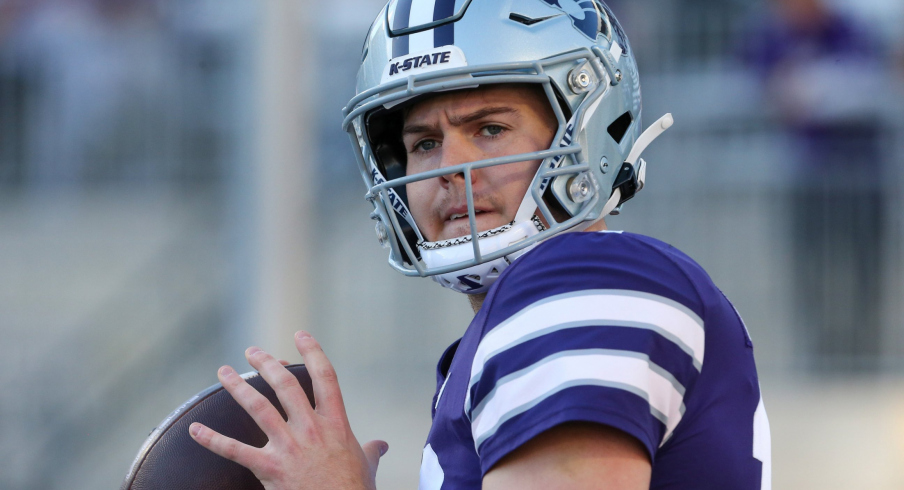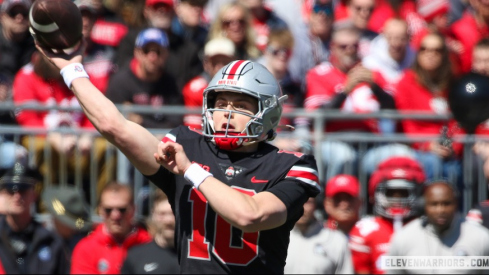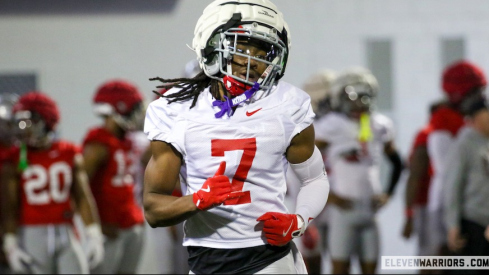Chris Klieman just completed his fifth season in Manhattan, Kansas, having amassed a 39-24 record that has seen just one losing season and includes the 2022 Big 12 title. Yet, that pales in comparison to what he accomplished in his previous job. During the five years in which he led North Dakota State, he lifted four national championship trophies while winning 69 games and losing just six.
As true 'ball-knowers' can attest, part of what made the Bison so successful during his run there was the program's commitment to an offense that still relied heavily on an old-school running game, perfectly executing A-gap Power over and over with a barrage of fullbacks and tight ends on the field. But although Klieman cut his teeth as a defensive coach before earning the head job in Fargo, he initially brought a similar offensive style to KSU upon taking over that program in 2019.
Initially, such a style seemed radical in the pass-happy Big 12, but Klieman's arrival coincided with a period in which Oklahoma dominated the conference primarily via a physical run game, albeit from the shotgun instead of the I-formation. Imitators took notice and today, the conference is much more balanced.
Even so, if you had told anyone in 2019 that a quarterback was transferring from Klieman's system to Ryan Day's, they would have likely looked at you sideways. But upon the elevation of former KSU legend Colin Klein from QB coach to coordinator two seasons ago, the Wildcat offense evolved into something far closer to what Buckeye fans are used to seeing.
Will Howard thrived as a result of this transition. Though he initially lost the starting quarterback job to Nebraska transfer Adrian Martinez, Howard led the Wildcats on four straight touchdown drives when he came on in relief of Martinez after he suffered an injury against TCU midway through the 2022 season. The junior from suburban Philadelphia finished the season with 1,633 passing yards, 14 touchdowns, and just four interceptions in seven games played, capping it off with an upset victory over the Horned Frogs in the conference championship game.
As my colleague Josh laid out recently, Howard put up numbers that closely mirrored Kyle McCord's this past season, leading many to question whether his addition to the roster is actually an upgrade for Ohio State. Of course, Howard brings a running element that separates him from McCord, having racked up 351 yards and nine touchdowns on the ground last season.
Despite Klieman's history with traditional, pro-style quarterbacks like Carson Wentz, a running element from that position should be no surprise given who was calling plays in the Little Apple. Klein starred as what was essentially a single-wing QB under the legendary Bill Snyder during his playing days in Manhattan, tallying 2,455 rushing yards and a staggering 55 touchdowns on the ground during his heralded career, earning a trip to the other Manhattan as a Heisman finalist in 2012.
Both Klein and Howard are 6'5" and it's clear that the former saw some of himself in the latter, utilizing him in a variety of option schemes that allowed the 240-pounder to use his combination of size and straight-line speed to pick up yards. Much as he often did while taking the snaps for K-State, Klein called for Howard to execute Power-Read as a staple of the offense last season, allowing the horizontal threat of a running back sweep to open up an inside running lane behind a pulling guard for the big, yet mobile, QB.
As an open-field runner, however, Howard is not going to be confused with Lamar Jackson or Justin Fields anytime soon. Knowing he wasn't going to make many people miss when moving laterally, Klein utilized Howard's strengths as a north/south runner and engineered interior option runs like the Midline option, rather than just relying on classic zone-read concepts that left a defensive end unblocked.
In these concepts, the offensive line gains a numerical blocking advantage by leaving an interior defensive lineman unblocked for the QB to read, allowing the rest of the blockers to get more bodies play-side.
Though they might be a little dusty at this point, such concepts are very much in Day's OSU playbook, as Justin Fields and J.T. Barrett regularly found success with them. This ability to equate numbers more effectively in the run game should be cause for excitement within the program, as Ohio State's transition from one of the nation's best running games with Fields to a relative weakness over the past three seasons might quickly be reversed.
But Howard is bringing more than just his legs to Columbus. This ability to quickly read designated defenders in the option game translated to the passing game, as well, as Klein dialed up a consistent diet of post-snap RPOs that married a run concept with screens, hitches, and slants.
Not only did Howard consistently read the isolated defender properly (such as the slot defender #37 in the example above), but he maintained excellent mechanics when doing so. Upon seeing the defender close down to play run, he quickly pulled the ball and flipped his hips in the direction of the receiver like a second baseman throwing to the shortstop on a double-play, allowing him to maintain a solid base and deliver an accurate throw on time.
But to assume that Howard was only asked to deliver the option concepts that have become common in college football over the past decade would be naive. While Klein recognized the opportunity to diversify the K-State running game upon his ascension to OC, many of the Pro-Style aspects Klieman's staff had brought from North Dakota State remained.
Though the Wildcats rarely lined up in a traditional I-formation, they often operated from 21 personnel with a fullback on the field. That fullback, however, happened to be Howard's best receiver, as Ben Sinnott (#34) would line up in the backfield one play, as a tight end the next, and in the slot the play after that, allowing KSU to operate from a variety of formations without substituting.
Sinnott's versatility earned him third-team All-America honors (as a tight end) this past season and allowed Klein and Howard to identify defensive schemes more easily. For instance, the Wildcats might line up with Sinnott as a second tight end to the boundary, signaling a run play and drawing the defense into a run blitz from the slot, only to throw a Four-Verticals concept that attacked the three-deep zone coverage.
Such pass concepts, which formerly were associated with the Air Raid but have since gone mainstream, can be found all over Kansas State film. Schemes like 4-Verts (above), Mesh (below), and Y-Cross that have been foundational concepts for Ryan Day and his staff appeared to hold a similar place in Klein's, albeit from heavier personnel.
Such familiarity should dramatically shorten Howard's learning curve, something he told ESPN's Pete Thamel upon his commitment to the Buckeyes:
"Talking to Coach Day about the scheme, I got excited," Howard said, stressing the appeal of the pro concepts in Ohio State's offense. "Kansas State is very pro-style and gets you ready for the pros better than most programs in the country. I didn't want to lose any of that momentum.
"When Coach Day and I met and went through the scheme, I'm a total football nerd and talk ball all day. We hit it off in that way. I knew that was the system that would get me the most prepared for that level."
Even though Day is expected to bring on a full-time offensive coordinator in the coming weeks, it's unlikely that the core elements of Ohio State's offense will change. Rather, Day will look for someone to lead the weekly game-planning and execution of the base philosophies that have allowed Buckeye quarterbacks to rewrite the record books since he arrived in 2017.
What should also make Day's life easier is the consistency of Howard's footwork in the pocket. The veteran consistently maintains a balanced base while moving, matching his front (left) foot with his eyes to allow him to throw an accurate strike quickly.
Howard has often shown a good understanding of defensive schemes and displays the same post-snap judgment shown in the option game when reading defenses downfield. For instance, Kansas shows an even look from its secondary in the video below, signaling some kind of 2-deep or quarters coverage before the snap. However, once the ball is in play, the Jayhawks rotate to a three-deep coverage with the field safety responsible for the middle of the field.
But Howard quickly sniffs out this late movement, recognizing instantly that the boundary safety is playing an underneath 'buzz' zone next to the linebacker, signaling he should look to the other side. He then buys enough time in the pocket for his tight end to turn around the deep safety before throwing a dart into the back of the end zone.
Knowing Howard was capable of working through his reads, many opponents elected to simply pressure him instead of letting him work in the pocket. According to Pro Football Focus, opponents blitzed Howard on 37% of his dropbacks last season. But with a big frame capable of taking hits, Howard showed little fear when defenders bore down on him and made numerous big throws in such scenarios.
As the numbers show, however, Howard was not immune from mistakes, throwing 10 interceptions on 358 attempts this past season. In many cases, these turnovers came from the confident QB trusting his eyes too much and getting baited by unexpected coverage schemes.
For instance, Oklahoma State drew him into an arm punt INT by playing a 3-Cloud coverage from the same three-high safety look Ohio State often ran this past season with former Cowboy DC Jim Knowles calling plays. While Howard kept his eyes on the field corner dropping into a deep third as a double-posts concept was run to that side in a Yankee concept, he never identified the deep safety in the middle of the field before launching a deep ball to the inside post that the defender easily intercepted.
While Howard typically displays better footwork than the QB he'll be replacing, there is a reason many believe he and Kyle McCord are quite similar. Despite making the right read to pull on the RPO below, for instance, he forced a pass into a slant to his left that wasn't open.
Such a decision is all too familiar and probably still #TooSoon for Buckeye fans.
While Howard was correct in not handing the ball off, based on the defense's numbers, he (like McCord) needs to learn when to simply throw such a pass away after making his initial read.
But although Howard resembles his predecessor in some ways, his mechanical consistency as a passer along with the threat he poses as a runner makes him a clear upgrade at the most important position on the field. While he may not be C.J. Stroud or Justin Fields, Howard should easily transition into his new system and distribute the football to a talented cast of playmakers around him.



